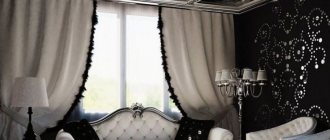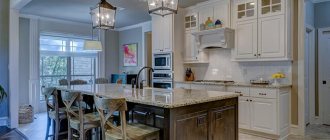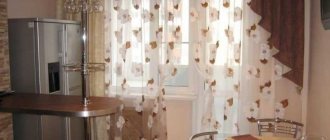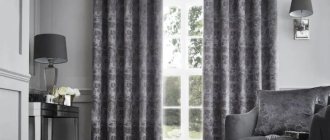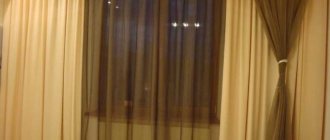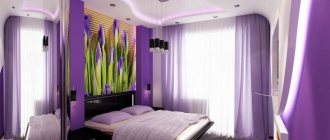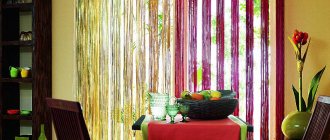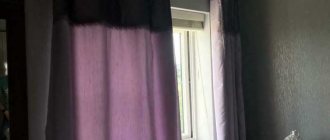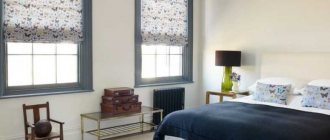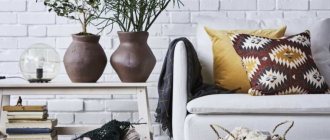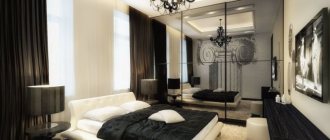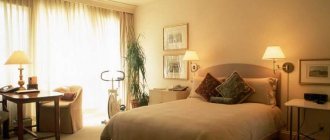If you are tired of classic and ordinary curtains of monotonous shapes and colors, then you can diversify them by using one detail.
You can use asymmetrical curtains. They will be able to change the appearance of the room and doorway.
The room will be unusual and individual. Curtains of this type can be used on doors and windows.
The photographs contain a large number of design examples of what the design of a room with asymmetrical curtains will look like.
They will fit into any interior and add romance and unusualness. Use your imagination and create an atmosphere that will be pleasant and cozy for you.
Peculiarities
With the use of asymmetrical curtains, you can create a variety of images of space.
Curtains of different lengths are a very popular type. This design option would be good for a balcony with a door.
You can make different lengths on only one side of the curtain. You can make air curtains attached diagonally.
One such curtain can completely cover a window opening.
The difference in length can be made by using different decorative techniques or simply by controlling the curtains differently. The curtain can be moved to one side and picked up in an original way.
So, you can experiment not only with the placement of the curtain and its material, but also with its color.
Several ways to design a window asymmetrically:
- Use curtains of different lengths. This option is most justified for a window with a balcony;
Asymmetrical, but simple - curtain on one side with a tie-down - Instead of two curtains, hang one wide one, securing it with a tie on only one side;
The design of the living room kitchen takes into account the furniture, thanks to which the curtains form a single ensemble with the interior in coral-brown tones - Choose an asymmetrical lambrequin according to style;
Delicate asymmetrical lambrequin for a window against the wall - Decorate the window with a curtain cut diagonally. On one side, only part of the window will be covered; on the other, the curtain can reach the window sill or the floor. Such a model, suitable just for the kitchen, is easy to create with your own hands;
Lambrequin curtains, cut on the bias, made in two layers - an option for the kitchen-living room - Decorate the opening with a multi-layer composition, where the curtain, lambrequin and curtain fabric consist of several parts of different shapes and lengths; Set of asymmetrical curtains (lambrequin, bishop sleeve, double curtain)
- Take advantage of “symmetrical asymmetry” - hang curtains on two adjacent windows on one side in a mirror image;
Light voile curtains of noble asphalt color decorate asymmetrically two windows in the living room - Play with color: choose identical curtains in different colors (or take one plain canvas, and the second with a pattern).
Bias curtain on one side for a kitchen with a balcony, in bright colors to match the interior
This, as they say, is where the nuances begin. Color and pattern are a special topic when creating asymmetry. Asymmetrical curtains in themselves are a powerful design technique. Variegation can cover up other details of the design idea. Therefore, below are some “color” tips for irregularly shaped curtains.
Kitchen window design
Large and heavy curtains are not suitable for the kitchen, but asymmetrical curtains are ideal for the kitchen.
In most cases, short curtains are used in the kitchen; they are practical and look beautiful. But you can also choose original asymmetrical curtains that will look quite appropriate.
Ways to care for blinds- Attic curtains - 70 photos of modern options in the interior!
- Modern curtains - Original design in the best interior (71 photos)
Advantages and disadvantages of asymmetrical curtains
This window design has several advantages, including:
- Easy to use - they open and close easily. The canvas is gathered into soft folds and fixed with a clamp;
- Safe to use near heating devices. When the stove is located next to each other, the curtain is assembled from the opposite side;
- Protection against accidental fire. Classic curtains can swell over a burning stove, causing the textiles to ignite. This will not happen with curtains assembled on one side, since they are well fixed;
- Less fabric consumption for sewing, which allows you to choose a more expensive model;
- Curtains allow more air to pass through, provide spaciousness and free space, which visually enlarges the kitchen;
- A large selection of different designs, allowing you to choose options for any style.
Green curtain with tieback
The disadvantages are mainly related to the characteristics of the curtains:
- A non-standard style is not suitable for interiors with many flashy accents, since the kitchen space will look overloaded and very colorful;
- Curtains do not provide the necessary darkening, which is not suitable for kitchens located on the south side;
- For classic interiors, this style is also not always appropriate, since this style is characterized by clear lines and symmetry.
One-sided curtain in combination with a lambrequin
Color spectrum
To create a design in which curtains will contribute, you need to choose their color correctly.
If asymmetrical curtains are made of one element, then it is better to use several shades. Curtains are not the same length, it is better to use one color.
If tulle creates asymmetry, you can use different shades.
Asymmetry can be created with different colors, which will look stylish and beautiful. The curtain will be the same length, but thanks to the different colors, visually it will look asymmetrical.
Color palette and designs: do not create dissonance
Don’t try to collect all the beautiful textiles that you have stored for the room into one ensemble on the windows. Instead of an “interior symphony” you get an “amateur artistic performance”. Here are some tips on how to maintain a sense of proportion when decorating a window with your own hands.
If the window composition as a whole is symmetrical, and there is only one “wrong” element in it, it is preferable to highlight it with color, or choose a darker tone.
It is advisable to leave two curtains of different lengths the same color. But in combination with identical curtains and an asymmetrical curtain, the color of the former can be contrasting.
In multi-layered ensembles it is better not to be colorful. If they consist entirely of transparent fabrics, let them all be plain. Choose shades based on how they look when placed on top of each other. If the composition is completed by curtains or a lambrequin, they can be with a pattern, but the tulle part remains monochromatic.
An example of a classic version of curtains with a lambrequin for the hall, curtain fabric with a pattern was used
Avoid combining two fabrics with different patterns. Such combinations are only possible for a professional.
Color selection
The color of curtains in the kitchen depends on its style, dimensions and the desire of the owner. Since the curtains are assembled from one side, the design will look more massive from there. To get a harmonious window composition, you need to choose the right color that does not stand out from the design and does not irritate the eyes.
White and brown curtains in the kitchen
- All pastel colors - both warm and cold (beige, soft pink, powdery, milky). These are neutral tones that do not visually squeeze the interior and look unobtrusive and neat;
Long dusty pink curtains
- White is a basic color that suits any style. It does not strain the eye and creates the effect of freedom. White curtains visually look smaller. White also reflects light well, which means the kitchen will be brighter. But it is worth considering that such curtains will quickly get dirty in a kitchen environment. It is better to take its shades - milky, baked milk, beige;
- Grey. A color that belongs to the neutral palette. It can also be used in almost all styles;
- Green and its palette are associated with nature and do not put pressure on people. They are found in classicism, minimalism or eco;
When choosing a pattern or patterns for one-sided curtains, only one thing is taken into account - their compliance with the kitchen design. The most popular prints are polka dots, checks, stripes, flowers. The contrast of close tones looks beautiful. If the kitchen has wallpaper with a pattern, then it is better to choose plain curtains so as not to overload the interior. Also, do not choose too bright designs, which can ruin the relaxing atmosphere.
Checkered curtains with eyelets combined with original tulle
If you don’t want to focus on the window, then it’s better to hang curtains to match the furniture, without choosing models with ruffles, draperies and catchy patterns. To prevent the curtains from blending into the walls, the canvases are chosen several shades lighter or darker. Neutral models are appropriate for a flashy setting, and a restrained interior will be transformed by a colorful pattern on the curtains.
Light curtains to match the set
In small kitchens, curtains made of light, transparent materials are appropriate, which visually expand the space and add air. To make the decor look neat, choose large patterns. Also, dark colors are not suitable for small kitchens, otherwise the decor will turn out gloomy and cramped. A one-sided shortened curtain looks easy in the interior, without weighing down or overloading the decor in the kitchen.
Transparent curtains in a small kitchen
What material is suitable for the kitchen
Kitchen specifications impose certain requirements on the material of curtains - they should not quickly become dirty and wrinkled, absorb odors from cooking, fade in the sun, and withstand frequent washing, changes in temperature and humidity. Basically, kitchen curtains are made from the following fabrics:
- Taffeta. Usually it is woven from silk, but for the kitchen it is better to take cotton-synthetic textiles. It is resistant to various stains, dries quickly and supports wet cleaning;
- Kisey or thread curtains. This type consists of many thin ropes. Excellent for kitchens, since stains and dirt are not noticeable on such curtains;
- Natural materials (cotton, linen, silk). They resist fire, do not wrinkle, look elegant and simple on the window;
- Viscose and polyester. These are synthetic materials that have increased strength and can easily cope with difficult kitchen conditions.
The transparency of curtains is of great importance. There are three types in total:
- Transparent material. It transmits approximately 70% of light and retains almost no light. There is always a lot of daylight in the kitchen, cooking and cleaning will be comfortable. But such transparent curtains are only suitable for kitchens located on the upper floors, as they do not provide privacy. These include thread curtains and tulle.
Single Sided Lace Sheer Tulle
- Scattering. These are curtains in the kitchen that let in maximum natural light, but scatter it throughout the space. Through them the room is hidden from prying eyes, but fully illuminated. These are, for example, satin curtains.
- Opaque. Its characteristics are similar to blackout, that is, the density blocks light, preventing it from penetrating into the kitchen. These are, for example, velvet curtains.
